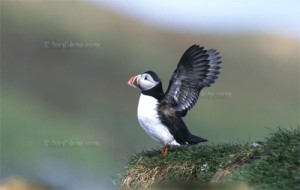 A high level of noise prevails especially in the breeding season on a typical bird cliff. Right in the middle an attentive observer might discover a colorful, stocky fellow with bright orange feet and beaks. Resting on the edge of the cliff, as if it is not concerned of all the fuss. This is the Atlantic Puffin (Fratercula arctica). You can see Puffins often in more or less large groups standing on rocky outcrops. Observing this bird for a while, you might see how a puffin after another flying – in a bumblebee-like flight and then gladly land to join its peers. Not only for the tourists this is a very popular species. So elegant and skillfully Puffins act underwater, so clumsy they act on landing and when staggering on the cliffs. That is why Puffin gain this special benevolence of many tourists of bird colonies. He acts as the needy comedians among seabirds, which you simply must give his sympathy.
A high level of noise prevails especially in the breeding season on a typical bird cliff. Right in the middle an attentive observer might discover a colorful, stocky fellow with bright orange feet and beaks. Resting on the edge of the cliff, as if it is not concerned of all the fuss. This is the Atlantic Puffin (Fratercula arctica). You can see Puffins often in more or less large groups standing on rocky outcrops. Observing this bird for a while, you might see how a puffin after another flying – in a bumblebee-like flight and then gladly land to join its peers. Not only for the tourists this is a very popular species. So elegant and skillfully Puffins act underwater, so clumsy they act on landing and when staggering on the cliffs. That is why Puffin gain this special benevolence of many tourists of bird colonies. He acts as the needy comedians among seabirds, which you simply must give his sympathy.
Often you can see on landing birds that they bring small longish fish exactly consecutively successive ranked in its beak. A rubbery-like band on the back of the beak make Puffins capable to open the beak without losing the already captured fish.
Puffins, this relatively petite bird, stand its ground in a crowded bird colony by settling in self-dug burrows. These burrows are dug usually up to 4 feet below the surface. Like most other seabirds they are colonial breeders. Underground Puffins rear their offspring. With feet and beak a comfortable housing is created that is safe from attacks by larger birds as sea gulls. As with the other Auks (Alcidae) e.g. the Murres, Puffins haves developed a special adjustment in combination of breeding security and enemy pressure that ensures survival of the species.
Life in the steep rock face of a bird island as Heligoland, Handa (Scotland) or Hornöya (or Hornøya in Northern Norway) is determined next to the Puffins by other Auks (Alcidae). Masses of small, mostly dark birds live on the very steep sections of a bird cliff. On a narrow ledge with minimal surface nesting Thick-billed Murres or Brünnich’s guillemots (Uria lomvia) and Common guillemots/ Murres (Uria aalge) find a suitable place to lay their eggs.
In addition to the Puffins and the Uria-Guillemots also other species of Auks live like Razorbills (Alca torda), Black guillemots (Cepphus grylle), Kittiwakes (Rissa tridactyla) and finally Shags (Phalacrocorax aristotelis) in a typical cliff. On some bird islands as Heligoland, Northern Gannets (Morus bassanus) breed, too.
In order to keep-up with the growing demand for top shots of the rarer bird species of the Palaearctic zone, bird-lens.com has undertaken targeted trips to bird areas in near and distant. This is to be able to do anything to offer excellent images of the birds of the Western Palearctic. The yield of images even of rare Western Palaearctic birds is very good. Very nice bird-images bird-lens.com could pursue among others in Europe in Scandinavia (Norway, Sweden, Finland, Denmark), in the Netherlands, in England, in Poland, in Austria, in France, in Portugal, in Spain and of course in Germany from the coast to Bayern.
The beautiful image of the blog is only a first impression of what you will find in behind the rider “Picture- Store” very soon. Just leave a message to bird-lens.com if you need a picture of a bird before new pictures are online.
Tags: